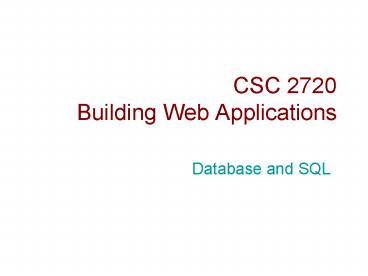CSC 2720 Building Web Applications - PowerPoint PPT Presentation
1 / 12
Title:
CSC 2720 Building Web Applications
Description:
Database Structured collection of records or data ... (ASP.NET) Stand alone App (Java / C / C ) Database Management Tools. SQL. SQL. SQL. SQL ... – PowerPoint PPT presentation
Number of Views:17
Avg rating:3.0/5.0
Title: CSC 2720 Building Web Applications
1
CSC 2720Building Web Applications
- Database and SQL
2
Database and DBMS
- Database Structured collection of records or
data - Database Management System (DBMS) Specialized
software for managing databases
3
Advantages of using DBMS
- Efficient Data Access
- Support multiple users and Data Security
- Protect access to data in which only authorized
users can access the data - Concurrent Access
- Support mechanisms to allow multiple users to
safely read/write the data. (e.g., record
locking) - Transaction
- Comprises of multiple indivisible operations
- A transaction must succeed or fail as a complete
unit it cannot remain in an intermediate state.
4
Advantages of using DBMS
Web App (PHP)
Web App (Java Servlet)
SQL
SQL
DBMS
SQL
SQL
Stand alone App (Java / C / C )
Web App (ASP.NET)
SQL
Database Management Tools
- Standardized query language for defining and
manipulating data - Network accessible
5
Introduction to Relational Database
- Relational Database A type of database in which
data are organized into related tables (a.k.a.
relations).
Column / Field / Attribute
ItemID Name Price Quantity
0123456 Coffee 4.50 100
0222222 Soy Milk 4.40 50
0142562 Tea 5.00 40
Row / Record
- A table has a name.
- A field has a name and a type.
6
Designing a Table Deciding column names and
types
- Name
- Should contain only letters, digits and
underscore - Meaningful
- Should not be a reserve word
- Should be less than 64 characters
- Should assume the name is case sensitive
- Three Primary Types
- Text (or Strings) CHAR, VARCHAR, etc.
- Numbers INT, DOUBLE, DECIMAL, etc.
- Dates and Times TIME, DATE, DATETIME, etc.
7
Some Common MySQL Types
Type Size (bytes) Description
CHARLength Length A fixed-length field from 0 to 255 characters long
VARCHARLength Length 1 or 2 A variable-length field from 0 to 65535 characters long
TINYINT / SMALLINT / MEDIUMINT / INT / BIGINT 1 / 2 / 3 / 4 / 8 Signed integers
FLOAT / DOUBLE 4 / 8 Single and Double precision floating point numbers
DECIMALLength, Decimals Length 1 or 2 A DOUBLE stored as a string, allowing for a fixed decimal point (Length of digits, Decimals of decimal places)
DATE 3 In the format YYYY-MM-DD
TIME 3 In the format of HHMMSS
DATETIME 8 In the format of YYYY-MM-DD HHMMSS
TIMESTAMP 4 In the format of YYYYMMDDHHMMSS acceptable range ends in the year 2037
8
Additional Field Properties
- NOT NULL
- Every field must be assigned a value or else an
error will occur. - DEFAULT default_value
- If a field is not assigned any value,
default_value is assumed. - AUTO_INCREMENT
- Use an integer that is one more than the current
largest integer as the default value - UNSIGNED
- A field can only hold non-negative integer.
- The range of positive integers is doubled.
9
SQL query to create a "Users" table
CREATE TABLE users ( user_id MEDIUMINT UNSIGNED
NOT NULL AUTO_INCREMENT, first_name VARCHAR(20)
NOT NULL, last_name VARCHAR(40) NOT NULL, email
VARCHAR(60) NOT NULL,pass CHAR(40) NOT
NULL, reg_date DATETIME NOT NULL, PRIMARY KEY
(user_id) )
- PRIMARY KEY (user_id)
- Indicates that the field user_id is to be used as
the primary key to identify the records in the
table
10
Characteristics of a Table
- A NULL value means no value.
- When defining a table, we can set whether a field
can contain a null value or not. - Keys are used to identify records in a table.
- A Primary key is a field (or combination of
fields) that uniquely identifies a record within
a table. - A Foreign key is a field (or combination of
fields) that serves as a primary key in another
table. It is used to establish a relationship
between a pair of tables. - Records are not ordered in a table.
11
Structured Query Language (SQL)
- A language that can be used to build, modify,
query, and manipulate a database - SQL supported by different DBMS may vary
slightly. - With SQL, you can
- Create/delete a database
- Create/delete tables in a database
- Retrieve data from a database
- Insert new records in a database
- Delete records from a database
- Update records in a database
12
SQL (con't)
- SQL is not case sensitive
- Multiple statements are separated by semicolon
- Important commands for manipulating data
- SELECT - extracts data from a database table
- UPDATE - updates data in a database table
- DELETE - deletes data from a database table
- INSERT INTO - inserts new data into a database
table - Important commands for manipulating table
- CREATE TABLE - creates a new database table
- ALTER TABLE - alters (changes) a database table
- DROP TABLE - deletes a database table
- Examples SQL Tutorial at W3Schools
- http//www.w3schools.com/sql/default.asp

